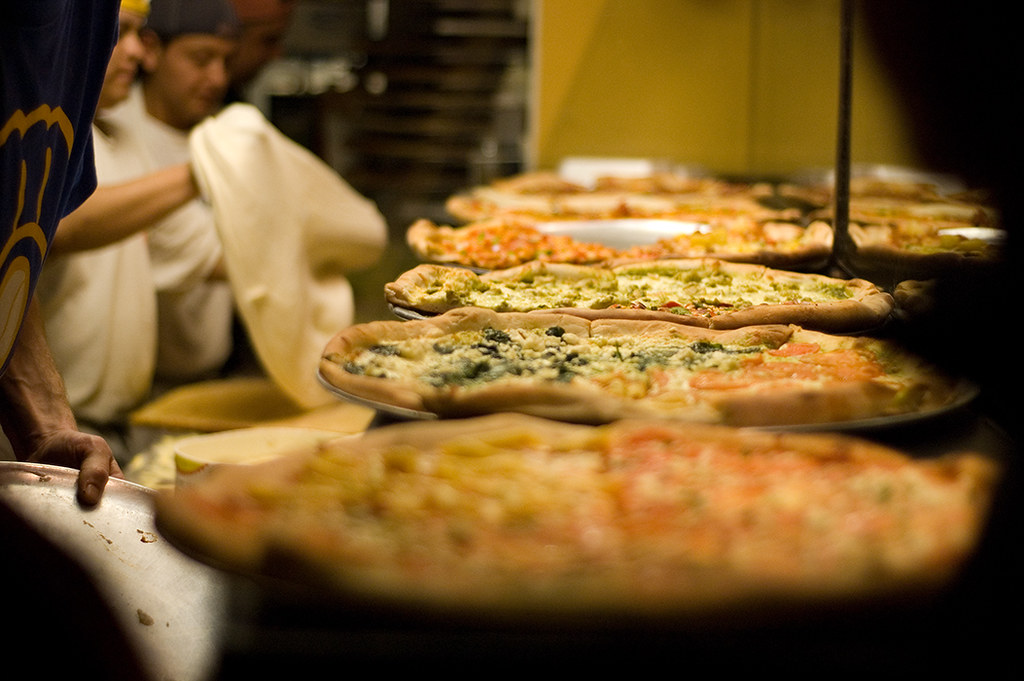We’ve all had that strong need for a hot, cheesy slice of pizza fresh from the oven as pizza lovers. What happens, though, if you don’t have a pizza tray? Do your hopes of a crispy crust have to be abandoned? Is it possible to bake pizza without a tray?
Pizza can be baked without using a tray. You can try a few other approaches:
- Pizza Tray Substitute: If you have a baking sheet or cookie sheet, you can use that in place of the pizza tray. Directly place the pizza on the baking sheet, then bake it as usual. The crust might not get as crispy as it would on a pizza stone or tray, so keep that in mind.
- Another choice is to put the pizza on a piece of parchment paper before setting it straight on the oven rack. Pizza won’t adhere to the parchment paper, making it simpler to move it into and out of the oven. Use parchment paper, but make sure it is oven-safe for the temperature you’re using.
- Pizza stone or baking stone: If you want to bake pizza without using a tray, a pizza stone is a great tool. Using a pizza peel or another flat, strong instrument, carefully transfer the pizza onto the hot stone after preheating it in the oven. The crispier crust will result from the stone’s assistance in distributing heat evenly.
- Oven Rack: If need be, you can just put the pizza on the rack in the oven. To prevent any drippings from dropping onto the oven floor, use caution when using this technique. To prevent spills or falling toppings, it is advised to line the lowest rack with a baking sheet.
Regardless of the approach you use, keep in mind that the direct contact with the heat source may alter the cooking process, so adjust your cooking time and temperature accordingly. You can get the desired outcomes by experimenting and keeping a tight eye on the pizza.

Will the bottom of the pizza be burnt if there is no tray used?
Without a pizza stone or tray, there is a danger that the bottom of the pizza will burn or get too crispy. This is because the dough may experience strong heat transfer from direct contact with the oven rack, particularly if the oven temperature is excessively high or the pizza is baked for an extended period of time.
Here are some suggestions to avoid scorching the bottom of the pizza:
- Oven temperature adjustment: A modest reduction in oven temperature can aid in preventing the bottom from burning. To discover the ideal temperature for your pizza, experiment with several settings.
- Elevate the pizza by placing a wire cooling rack on top of a baking sheet, if at all possible. With this arrangement, the pizza will be slightly elevated, enabling air to flow underneath and preventing the bottom from becoming overheated.
- Watch the cooking process: During baking, keep a tight check on the pizza. Regularly check the bottom crust to make sure it doesn’t burn or brown too much. If necessary, alter the cooking period.
Keep in mind that the precise result may differ based on your oven, the thickness of the dough, and the toppings used. Finding the perfect technique and temperature for your homemade pizza without a tray may require some trial and error.

How do you stop the pizza from sticking to the oven rack?
You can use the following methods and advice to lessen the likelihood that the pizza will adhere to the oven rack:
- Use a baking mat or parchment paper: Prior to laying the pizza on top, line the oven rack with parchment paper or a silicone baking mat to make the surface non-stick. The pizza will be simpler to slide into and out of the oven thanks to this barrier, which will keep the dough from adhering to the rack.
- Dust the rack with cornmeal or flour: Directly onto the oven rack, sprinkle a thin layer of flour or cornmeal to create a dry surface that will assist lessen sticking. The dough and the rack are separated from one another by the flour or cornmeal.
- Cooking oil can also be lightly brushed or sprayed onto the oven rack as an alternative. This can make the surface non-stick and make it easier for the pizza to slip off after baking. However, use caution when adding oil, since too much can result in smoke or spilling while baking.
- Pre-heat the oven appropriately: Before putting the pizza inside, make sure the oven is completely warmed up. The environment a properly warmed oven generates helps the pizza dough cook more evenly and decreases the likelihood of sticking.
- Transfer the pizza using a pizza peel or flat surface: If you’re using a baking sheet or parchment paper to hold the pizza, lift it onto the oven rack with the help of a pizza peel or a flat surface (such a cutting board or another baking sheet). The likelihood of the dough adhering to the rack during the transfer is reduced by using this technique.
To prevent any unintentional sticking or tearing, handle the pizza gently both when putting it in the oven and when taking it out after baking. Combining these methods will increase the possibility that the pizza won’t adhere to the oven rack and guarantee a good baking process.
Relevant Articles
What Is A Pizza Crisper? Is It The Same As A Pizza Pan?

Comments are closed